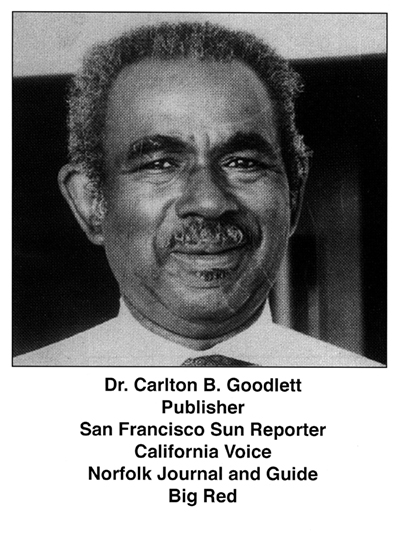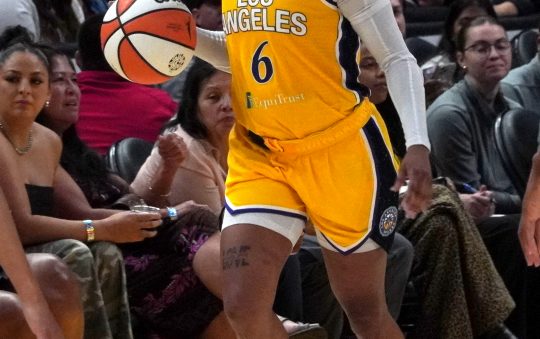
Dr. Carlton B. Goodlett, the publisher
by Yussuf J. Simmonds
Carlton Goodlett
“Medical Doctor, Businessman, Scholar, Civil Rights Activist and Publisher”
Born in July 1914, in Chipley, Florida, Carlton Benjamin Goodlett lived a full life, doing good for the people for whom he cared which earned him the moniker, ‘champion of the people’. His parents were a schoolteacher and a sawmill worker, and they wanted what they believed was a better future for their son.
After finishing elementary and high school, Goodlett went to Howard University in Washington, D.C. where he earned a bachelor’s degree. During his years at Howard, Goodlett was president of the student body and editor of the student newspaper; the latter would serve him well in his future endeavors as a newspaper publisher. Then he followed that with a Ph.D. in psychology–one of the first Blacks to do so–from the University of California at Berkeley. He had come to Berkeley with the intention of studying for a master’s degree. But he changed his mind on arrival, and took the preliminary examination for a Ph.D. After three years of hectic preparations, he received his doctorate in child psychology at the age of 23. For a few years, Dr. Goodlett worked as a professor at West Virginia State College then he went on to Meharry Medical College in Nashville, Tennessee, where he earned a medical degree in pediatrics in 1944 at the age of 29. (Before he was 30, Dr. Goodlett was a doctor again, an M.D and a Ph.D.).
The following year, he relocated to San Francisco and opened a family practice in San Francisco; there, as a doctor, he learned firsthand the bitter reality of racism. At that time, Dr. Goodlett was one of only three Black doctors in the city. They were only permitted to see patients in their offices, not in any of the hospitals–not even the public hospitals.
Under Dr. Goodlett’s leadership, they won the right to have access for themselves and for future non-White doctors to see patients at all public hospitals in the city.
After three years, using the money he earned as a physician, he bought a small weekly, The Reporter followed by a subsequent acquisition of another weekly, The Sun, a rival newspaper from its White owner. Dr. Goodlett merged both newspapers and produced The Sun Reporter becoming the publisher of the Reporter Publishing Company. Dr. Goodlett, the publisher, was still a family doctor.
He would use his position as a newspaper publisher to press for civil rights, better social and economic conditions, and a better quality of life for Black people. In essence, Dr. Goodlett launched a steady assault on racism wherever he found it and in whatever form it appeared. He used his newspaper as a voice for the voiceless particularly in the Bay Area, his base of operations. The Sun Reporter became San Francisco’s best-known Black weekly newspaper as a crusading newspaper under his direction; its motto was, “That no good cause shall lack a champion, evil shall not thrive unopposed.” It also became his flagship paper. Dr. Goodlett strongly believed that Black people needed their own media outlets ‘to tell their own stories accurately’ for posterity and for researchers to use later on to record and tell Black people’s history correctly and in proper context.
It was during this time that Dr. Goodlett, as a publisher, began to champion the causes of the “little” people. He would fight for the rights for equal access to jobs, schools, and opportunity. As a doctor and publisher, he routinely had a busy schedule but would still find the time to lead various causes. For example in 1947, he led the fight against San Francisco’s public transit for failing to hire Black workers which eventually led to the transit’s workforce becoming over 40 percent African American. This eventually led to the eventual desegregation of the city’s municipal labor unions and improvements in public housing. He served as president of the San Francisco NAACP from 1947-49.
In addition to The Sun Reporter, Dr. Goodlett became the publisher of eight affiliated papers including the California Voice, and Norfolk Journal and Guide, and a tireless advocate for the rights of the downtrodden. Not only would Dr. Goodlett use his role as a publisher to advance civil rights causes, as stated previously, he would actually get involve in, what he considered important issues, and be physically “on the frontline.” When W.E.B. Du Bois and Paul Robeson came to San Francisco, during the 1950s, they were shunned, even by Blacks, because of their open involvement with socialism. It was Dr. Goodlett who took the lead in hosting their respective visits when no one else would. He arranged for them to speak at the Third Baptist Church.
Doctor, publisher, civil rights activist, Dr. Goodlett also accepted the invitation to join the faculty of the California Labor School. Established by the International Longshoremen’s and Warehousemen’s Union, it was regarded by some as being communists, or at least a communist front organization. Dr. Goodlett saw the need for his advocacy on their behalf and offered his services. He began to be called a communist sympathizer and some so-called red-baiters believed that if he was not one of them at least, he was a ‘fellow-traveler’.
Because of his various activities, it seemed inevitable that Dr. Goodlett would be drawn into the maze of politics, and he did. Those who knew him well said that it was not for personal gain, but for the inclusion of all Black people in the state and nation to enjoy the freedoms that everyone else seemed to enjoy. And as an articulate orator, his name became identified as a solver of social problems. He worked with the liberal community very closely, particularly with the liberal unions.
When he first established his medical practice in San Francisco, Dr. Goodlett shared the office building with one Dr. Daniel Collins, a Black dentist, who was also a faculty member at the University of California Dental School. It was the Collins-Goodlett combination that organized the Democratic Party’s first Black club in the city.
In 1951, Dr. Goodlett joined the National Newspaper Publishers Association (NNPA), the Black Press of America, and served three terms as its president. He also served as chair of the California Black Leadership Council and as president of the San Francisco NAACP, he had led a protest against the Municipal Railway for discrimination of African-Americans.
Because of these and other activities, he became noticed by the California Democratic Party.
In 1963, Dr. Goodlett built a two-story office building, a combination of his medical office and newspaper office in San Francisco’s Fillmore district. The closeness of his businesses made sense practically,
logistically and economically. It allowed him to operate his medical practice and run the newspaper more efficiently. With his medical practice and the Sun-Reporter’s business department on the first floor, and the production department and a large room–known as the community room–used for private social gatherings on the second floor. The office building became a Mecca for the civil rights movement in the city.
The community room became a focal point for the social, political, religious and community events. It would eventually host a variety of dignitaries including Malcolm X, Muhammad Ali, Dick Gregory, and the Black Panthers. Some young and talented journalists started their careers at the Sun-Reporter and moved on, including Lance Gilmore, Edith Austin, Belva Davis, Valerie Coleman and many more. Politicians came to Dr. Goodlett for advice, counsel and his ability to reach the people; they included Governor Jerry Brown; Willie Brown (former Speaker and Mayor of San Francisco); Ron Dellums (former Congressman and Mayor of Oakland); Congresswoman Barbara Lee; Mervyn Dymally (former Lieutenant-governor and Congressman); Dolores Huerta (United Farm Workers); Cecil Poole (former U.S. Attorney and Federal Judge), and many other prominent political figures. It was said that an endorsement from Carlton Goodlett was important to the election of many political leaders.
His first foray into the rough-and-tumble, California state politics was in 1966: he ran for Governor of California in the Democratic primaries, with Sy Cassidy, Dick Gregory and Rev. A. Cecil Williams as his high-profile supporters in the ‘Goodlett for Governor’ campaign. His campaign slogan was “The people are wise–wiser than the politician thinks!” a platform that demanded “an economic floor below which no one can fall!” Though Dr. Goodlett lost in the Democratic primary, his call for Governor Pat Brown to “go into the ghettos of Watts and Oakland” resonated throughout the Governor’s unsuccessful campaign for re-election. He came in third in a field of six. He was the first Black American since Reconstruction to mount a serious candidacy for the governorship of California.
As a ‘fellow-traveler,’ community activist, but most importantly as a Blackman, Dr. Goodlett also bore the brunt of being arrested without cause.
According to the report, he was pulled over by a motorcycle cop for an alleged traffic violation, but refused to submit to the indignities and was eventually arrested, handcuffed, taken to the Hall of Justice and booked for resisting an officer. The next day when he appeared in court, the courtroom was packed. The arresting officer never showed up and the charges were dropped. Then in 1968, Dr. Goodlett was arrested at San Francisco State University during protests by students demanding a Black studies department–which they eventually got; it became the first university to have a Black Studies program.
An opponent of the Vietnam War, Dr. Goodlett was a member of the World Peace Council and traveled many times to the Soviet Union and other socialist countries. He also visited Vietnam in 1975. Dr. Goodlett supported every progressive struggle and participated at all levels in the Civil Rights Movement. In addition to his involvement with the NAACP and NNPA, he was on the board of the National Black United Fund, California Black Leadership Conference, the William L. Patterson Foundation, Morehouse Medical College and the Soviet Front World Peace Council.
In 1962, Dr. Goodlett had participated in a disarmament conference in Moscow and during the 1960s and 1970s, his opposition to nuclear weapons and his participation in the World Peace Council led him to make several trips abroad to cities such as Stockholm, East Berlin, Prague, Budapest, and Copenhagen. In 1970, Dr. Goodlett attended a World Peace Conference in Stockholm where he was awarded the Lenin Peace Medal. He described the Gulf War as the U.S. genocide in Iraq and helped host a benefit for the National Coalition to End the U.S. War in the Middle East.
Dr. Goodlett served the community as a doctor, a publisher and a champion for civil rights for about 40 years; he built the Reporter Publishing Company weekly newspaper chain into a circulation of 160,000 copies, remaining their publisher until he died in 1997 at the age of 82 at his home in Cedar Rapids, Iowa. The cause was Parkinson’s disease. He was survived by his son, Dr. Garry M. Goodlett.
At Dr. Goodlett’s memorial, two doctors–Drs. Ahimsa Sumchai and Ramona Tascoe Burris–who he had encouraged to become doctors spoke. Dr. Sumchai:
“I didn’t want to be like Dr. Goodlett, I wanted to be him.” Dr. Burris: “Carlton took me aside and said I really needed to become a doctor. I was about to enter law school.” Dr. Goodlett convinced many African American youth to enter the medical field.
In January 1999, San Francisco Mayor Willie Brown officially renamed the address of City Hall to 1 Dr. Carlton B. Goodlett Place.






